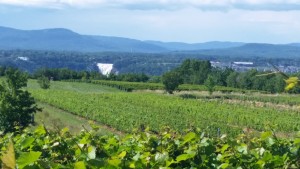Well, maybe not in Québec City, but just outside, only minutes away. So that counts.
The locale is the Ile d’Orléans, only 15 minutes’ drive from the center of the city, reached by a bridge over the St. Lawrence River. As it happens, we have a home in Québec City, where Lucie is from. Ile d’Orléans is an island in the middle of the St. Lawrence River, just downstream from Québec City. It is 21 miles long and five miles wide at its broadest point. A lot of French-speaking Canada originated here. It is primarily farm land, the fruit and vegetable basket of Québec City. Now the farms include vineyards.
The climate as far north as Ile d’Orléans might lead you to believe that it is impossible to discover winemaking there, but if the fifty United States can each boast at least one winery, why not the province of Québec (of which Québec City is the capital)? Of course, the grapes that grow so well in warmer climes don’t do well there, so the local winemakers use such grapes as Frontenac, St. Croix, Maréchal Foch, Vandal, Hibernal and Vidal. These have been specially developed to withstand short summers and harsh winters, many by agriculturists at the University of Minnesota. (Take that, UC Davis!)
In 1535 the French explorer, Jacques Cartier, set foot on the island and because of the abundance of wild grapes growing, he called it Ile de Bacchus. At least to the tastes of those of us who are used to the grapes of Bordeaux, the Rhône and Italy, the wines here aren’t great. To be honest they cannot be compared, because of different grapes, climates and terroir. It’s amazing that they still can grow wine grapes there at all! The grand exception to that warning is, not surprisingly, the ice wines from the island, many made from Vidal grapes. In tasting terms, these dessert wines make the trip worthwhile. One of our favorite wineries there is Vignoble du Mitan; we enjoyed their red wine Le Rigolet but really love L’insulaire, their late harvest wine. But truly, these delightful wines are not the only reason to make the trip.
If you get a day with ample sunshine, you will cross that bridge to find charming villages with the narrow-steepled churches that are the signature architecture of Québec. There are numerous fruit stands and a very popular chocolate and ice cream shop in Ste. Pétronille, five minutes from the bridge. You will have matchless views of the St. Lawrence River, Québec City and just on the other shore, the Chutes Montmorency, a waterfall 98 feet higher than Niagara Falls. You can pack a picnic and enjoy it at many of the wineries or you can have lunch at one of the many inns and restaurants that dot the island. Two of our favorites are Auberge La Goéliche (just beyond the chocolatier in the village of Ste. Pétronille) and the ancient Moulin de St. Laurent in the village of St. Laurent. The food is good in both places but the atmosphere is better.

The vineyards of Ste. Petronille with the Montmorency Falls and the Laurentide Mountains in the background
There are five wineries you can visit: Domaine de la source à Marguerite, Vignoble du Mitan, Le Vignoble de Sainte-Pétronille, Vignoble de l’Isle de Bacchus and Cassis Monna et filles. Cassis Monna makes fruit wines and a creditable crème de cassis; the others make table and dessert wines. Each winery has its own personality and history and its own charm. Many sell other agricultural products, often derived from maple syrup and the vegetables that Ile d’Orléans supplies to the city folks. We also enjoy stopping for a beer at the Pub Le Mitan, a microbrewery, to get phenomenal views of the river and the cliffs beyond.
We, as a born Québécoise and as an adopted one, urge you to visit Québec City, the closest you can get to France without crossing an ocean … and without the French themselves (that’s Lucie talking here). Take in the history, the cafés, the cultural festivals, the joie de vivre. And leave a little time for some wine discoveries on the Ile d’Orléans.
